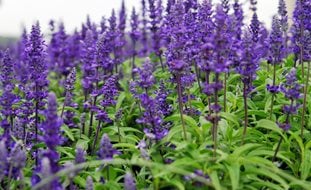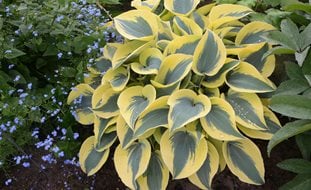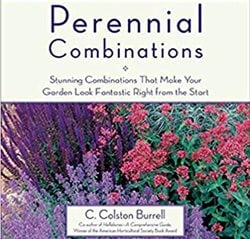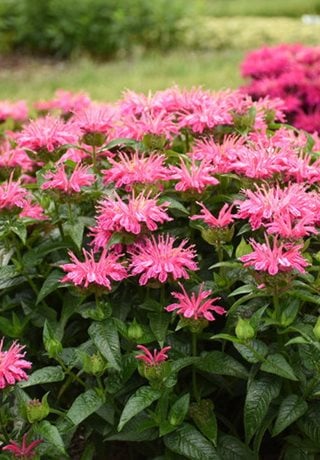Perennials - How to Grow and Design with Perennial Plants and Flowers
How to use perennial flowers and plants for year-after-year color in your gardenPerennials are plants that come back year after year. Some are evergreen and keep their foliage through the winter; others go dormant, dying back to the ground and will send up new shoots in the spring. They usually only bloom for one season each year, either spring, summer, or fall; although there are some re-blooming and ever-blooming varieties. Perennials tend to have fewer flowers than annuals, because their energy is put into developing strong roots instead of flowers and seeds. Keep reading below to learn more about growing and caring for perennials.

Here are 18 popular choices to get you started.

Brighten up your landscape with these sun-loving perennial plants.

Lighten up shady areas of your yard with these reliable perennials.

Include these perennial plants in your landscape to minimize damage from deer.

Turn a patch of your garden into a banquet for beneficial insects by putting these native plants on the menu.

Add late-season color to your landscape with these reliable fall bloomers.

Grow ornamental sages to attract hummingbirds, butterflies, and bees to your garden.

Shade-loving hostas are versatile, durable, and available in a variety of sizes and shades of green.

How to grow and care for these popular, easy-care, sun-loving flowers.

Learn how to grow peony flowers with planting and care advice from the pros.

A long bloom season, handsome foliage, and carefree performance are just a few of the allures of this versatile perennial.

Daisy-like yellow flowers that last for weeks bring non-stop color to your late-summer garden.
TYPES OF PERENNIALS
There are four main types:
- Short-lived types last 2 to 3 years.
- Long-lived types live 5 years or more.
- Herbaceous types have soft green stems and die back to the ground each winter in colder zones.
- Woody types may lose their leaves in fall or winter, but the root systems and stems stay alive.
POPULAR VARIETIES
There is a perennial to fill virtually any garden need:
Foliage:
Options ranging from plain to variegated, large or feathery, in colors from chartreuse green leaves to dark purple.
Color:
Choose perennials that bloom in colors from white flowers to almost black.
Size:
Varieties from a few inches to a few feet tall and wide.
Location:
Selections suitable for locations that get full sun to full shade.
Soil type:
Although most prefer well-drained soil, there are others suited for wetter locations.
Here are some of the most popular garden perennials:
- Peony
- Salvia
- Hosta
- Black-Eyed Susan
- Daylily
- Delphinium
- Yarrow achillea
- Phlox
- Sedum/Stonecrop
- Coreopsis
- Bee Balm
- Pinks/Dianthus
- Astilbe
- Russian Sage
- Shasta Daisy
- Agapanthus
- Coral Bells
- Catmint
- Agastache
- Veronica/Speedwell
- Allium
- Blanket Flower
- Primrose
Tip: Get your favorites delivered right to your door by ordering perennials online from Proven Winners. You'll get healthy and vigorous plants shipped at the perfect time for planting.
SOIL PREPARATION
In their book, Essential Perennials, authors Ruth Rogers Clausen and Thomas Christopher stress the importance of soil prep. "When cultivating annuals or vegetables, you have the opportunity to refresh and redig the soil every growing season. With perennials, however, this is not possible, so extra care must be taken to prepare the soil well and thoroughtly before planting."
- Determine soil type: Performing a soil test will give you a baseline to start from. There are simple test kits that can be purchased, or more in depth testing can be done by sending a sample to your state's Cooperative Extension Service.
- Test for proper drainage: To see if you have well-draining soil (required by the vast majority of perennials), dig a 12 x 12 x 12 hole and fill with water. If the hole drains within 1 to 4 hours, that would be considered well-draining soil. If it drains any faster, your plants will dry out too fast; taking longer to drain would result in soggy conditions that can cause root and stem rot.
- Amend as needed: To increase drainage, add organic material such as shredded leaves or compost, to the soil. For plants that require sandy soil, Clausen and Christopher recommend adding a 50/50 mixture of organic material and coarse sand (not regular sand which can turn to concrete in some conditions).
PLANTING
- Plants that have gotten leggy in their containers can be encouraged to grow fuller and healthier by cutting them back by one-third to one-half before planting.
- If plants are dry in their containers, give them a good watering the night before planting.
- Dig the planting hole at least 2 times the size of the root ball and incorporate organic matter and a slow-release fertilizer into the hole and the backfill. DiSabato-Aust says, “This helps prevent the plant’s roots from growing into soil that has not been properly prepared while the new plant is establishing.”
- Gently remove the plant from its container and loosen the roots if the plant has become rootbound.
- Plant at the same depth as they were in their container.
- Firm the plants into the soil with your hands and gently tamp the soil around them.
- Water well by hand immediately after planting.
- Water at the base of the plant toward the rootball and avoid wetting the foliage.
- Add a 2-inch layer of mulch around the plant to help hold in moisture and suppress weeds. Keep mulch away from the crown and stems of the plant.
- When done planting, check with your local nursery to see if they accept plastic pots returned for recycling.
WATERING
- The best time of day to water is in the morning.
- As a general rule, they will need the equivalent of 1 inch of water per week while becoming established in their first year.
- Water newly planted perennials shallower and more frequently for the first month because their roots aren’t very deep yet.
- After that, water deeper and less frequently to encourage the roots to go deeper; this will improve their drought tolerance.
CARE AND MAINTENANCE
In general, perennials require less work than annuals, simply because they last longer than one season and don’t require replacing every year. “Regional differences in climate and soil conditions dramatically affect a plant’s performance. A perennial can be high maintenance in one area because it grows like a weed, while in another region it can be low maintenance because it grows at a modest pace,” says author Tracy DiSabato-Aust in her book The Well-Tended Perennial Garden. Basic maintenance involves some, or all, of the following:
- Dividing: Plants that last more than a couple of years may eventually need to be divided, but not all do. Learn how & when to divide perennials.
- Deadheading: Some will require deadheading of spent blooms to encourage more blooms, and others simply to look their best.
- Pruning: Some may require cutting back once or twice a year, and others may need to be cut back to the ground in winter.
- Fertilizing: To be healthy enough to grow for years, some may require regular applications of fertilizer during the growing season, others just once in spring.
- Overwintering: Perennials in containers may need special care to ensure their survival over winter. Learn how to successfully get your potted perennials through until spring in this 6-step guide from Proven Winners.
PERENNIAL GARDEN DESIGN
- Arrange plants according to your plan while still in their pots. This way you can get an overall view and make any adjustments before you start digging.
- Consider the exposure (full sun, part sun, shade), soil type, drainage, and wind patterns of a location and select plants accordingly.
- DiSabato-Aust says that planting closer together can produce a lush, full style, but may also lead to more maintenance with pruning or transplanting if plants become crowded.
- Combine early-season bloomers with mid- and late-season bloomers for a long-lasting display.
- Mix in annuals for additional summer flowers.
With so many to choose from in a wide variety of colors, shapes, sizes, and textures, take a cue from the gardens below for good ideas on how to design a perennial border, use them to add interest to a meadow, and more.
- A Rustic Perennial Paradise
- Top Perennial Plants for a Butterfly Garden
- Piet Oudulf’s Next Wave
- Hamptons Haven
- A Cool, Quiet Corner of the World
- Beautiful Foliage Plants for Your Perennial Garden
Recommended books on perennials:
Reader Questions
Q: My neighbor tells me fall is the time to divide peonies. Can this be right? Are there other perennials I should divide then?
A: Dividing Peonies & Other Perennials
Q: Is there a trick to growing perennials from seed? I’m intimidated by the process. Can you help get me started?
A: Perennials from Seed
Q: I cleared an 80 by 10 feet strip along the side of my yard for my longtime dream - a large perennial border. While I was full of optimism digging up the grass and amending the soil, I’m now overwhelmed by the process of designing the border. I have a good idea of what plants I want, but how do I incorporate them effectively on such a large scale?
A: Perennial Borders
Get more gardening advice.











